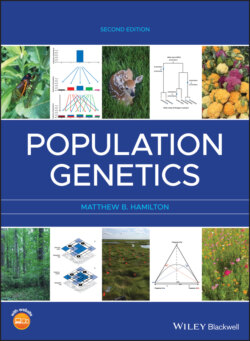Читать книгу Population Genetics - Matthew B. Hamilton - Страница 57
Problem box 2.3 answer
ОглавлениеThe first step is to hypothesize genotypes under the two models of inheritance, as shown in Tables 2.6 and 2.7 for blood groups. Then, these genotypes can be used to estimate allele frequencies (here, p indicates probability or frequency). For the hypothesis of two loci with two alleles each:
For the hypothesis of one locus with three alleles:
The expected numbers of each genotype as well as the differences between the observed and expected genotype frequencies are worked out in the tables. For the hypothesis of two loci with two alleles each, χ2 = 0.266, whereas χ2 = 19 688 for the hypothesis of one locus with three alleles. Both of these tests have one degree of freedom (4 genotypes −2 for estimated allele frequencies −1 for the test), giving a critical value of χ20.05,1 = 3.84 from Table 2.5. The deviations between observed and expected genotype frequencies could easily be due to chance under the hypothesis of two loci with two alleles each. However, the observed genotype frequencies are extremely unlikely under the hypothesis of three alleles at one locus since the deviations between observed and expected genotype frequencies are very large.
| Phenotype | Genotype | Observed | Expected number of genotypes | Observed − expected | (Observed − expected)2/expected |
| Hypothesis 1: two loci with two alleles each | |||||
| Purple/smooth | A_B_ | 2058 | 3816 (1–0.522)(1–0.512) = 2060.0 | 2.0 | 0.002 |
| Purple/wrinkled | A_bb | 728 | 3816 (1–0.522)(0.51)2 = 724.2 | 3.8 | 0.020 |
| Yellow/smooth | aaB_ | 769 | 3816 (0.52)2(1–0.512) = 763.5 | 5.5 | 0.040 |
| Yellow/wrinkled | Aabb | 261 | 3816 (0.52)2(0.51)2 = 268.4 | −7.4 | 0.204 |
| Hypothesis 2: one locus with three alleles | |||||
| Purple/smooth | AB | 2058 | 3816 (2(0.48)(0.49)) = 1795 | 63.0 | 38.5 |
| Purple/wrinkled | AA, AC | 728 | 3816 ((0.48)2 + 2(0.48)(0.03)) = 989.1 | −261.1 | 68.9 |
| Yellow/smooth | BB, BC | 769 | 3816 ((0.49)2 + 2(0.49)(0.03)) = 1028.4 | − 259.4 | 63.7 |
| Yellow/wrinkled | CC | 261 | 3816 (0.03)2 = 3.4 | 257.6 | 19 517.0 |
